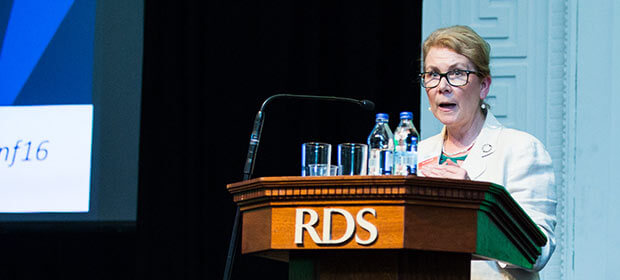Women’s entry into leadership was impeded by gendered division of labour, gender bias/misrecognition, management and masculinity and greedy organisations, Prof. Anne Scott, Professor and Vice President for Equality and Diversity, National University of Ireland, Galway, told the Conference.

Speaking on 21st century leadership, Prof. Scott, spelled out her vision of what was required of leadership and how health service managers could make the patients’ experience more simple and a great deal more sympathetic.
Looking at the challenges facing the health services, she said people were starting from a perception of scarcity rather than considering the resources to be allocated.
“We need to focus on allocation, delivery and the people who deliver the services,” she said.
“Health services have been described as authoritarian and some people experience them as punitive. This doesn’t bode well for the culture of a safe quality service.
“To develop the culture of a safe, quality service, we need to focus on evidence based competence, respect, empowerment, autonomy, responsibility and accountability.
“What is required of leadership is sympathy and support of core functions, an understanding of the nature and complexity of the organisms, a clear and accurate conceptualisation of the nature of the service, an ability to challenge constructively and demand high performance from all actors, across all functions and the courage and willingness to share power in a distributive leadership model.”
Prof. Scott said that distributed leadership required a visionary leader who was comfortable sharing power, generous in doing so, capable of seeing extraordinary potential in ordinary people and somebody who could make decisions with a balance of idealism and pragmatism.
Turning to how well our staff, management and leadership cadres reflected our population she said women and ethnic minorities were under-represented across all decision making fora – on committees, boards, recruitment panels and the executive.
She said that inclusive leadership required that we did things to make it happen. These included blind auditions, anonymised applications, training and data.
“Others – not ourselves – are our best guards against our unconscious biases” she said.
She queried as to how often and how effectively we sought the input to decision making of those at the front line in care delivery, how we were assessing impacts of change on health service delivery and what of the evidence base.
The message of the Francis Report, and reports by HIQA, the Department of Health and others was that it was not only individual practitioners who were to blame. The leadership, culture and structures within which these practitioners worked were also significantly blameworthy.
Only focusing on the financial bottom line does not work – nor does a culture of command and control.
“The demands of leadership in the 21st century are an appropriate skill set to equip one for the job, the courage and confidence to challenge, clear commitment to use the full range of skills of colleagues in the service to enable the service to be the very best possible and have our eyes open to the impact of developments internationally.
“What I have learned about effective leadership is that it needs clear, inspiring and energising vision. A leader needs to lead by example and give confidence that the vision is achievable.
“Trust your colleagues – must people are good at their jobs – and want to do a good job. Roll up your sleeves and engage with colleagues and support them in the work, use and develop the evidence base to drive change, assess your team, let those who can run with the job do so and manage those who need to be managed – it’s bad for morale if this does not happen.
“Leaders should also support good ideas, empower staff to do the job and be there to pick up the pieces when some of it inevitably goes wrong. You need two ears and one mouth. Benchmark externally, challenge where necessary, have different elements and levels of staff represented in decision-making and rigorously evaluate personal and team effectiveness.”

